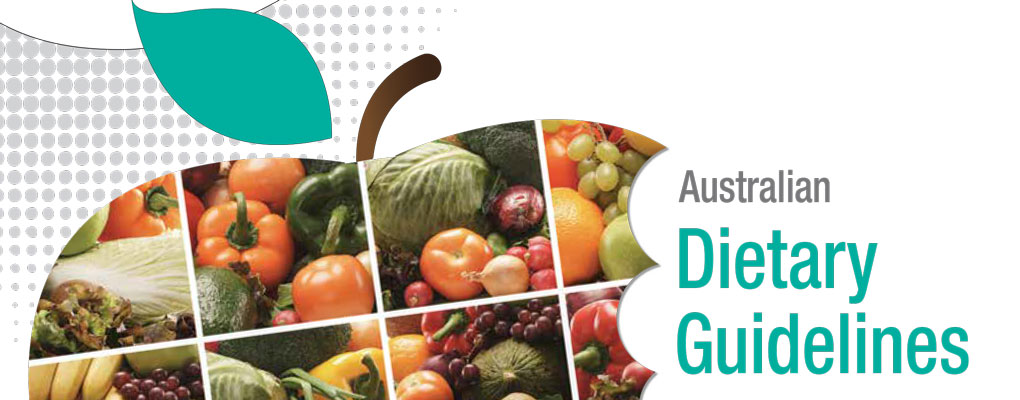
The Guidelines aim to promote the benefits of healthy eating in an effort to reduce the risk of diet-related disease (in particular type 2 diabetes, cardiovascular disease and cancer) and improve community health and well being. The Guidelines have been publicly endorsed by Nutrition Australia and The Dietitians Association of Australia. The Heart Foundation and the Tree Nut Industry are thrilled to see that nuts are back on the menu and unsurprisingly The Australian Food and Grocery Council have their nose out of joint about the recommendation to limit added sugar.
To achieve and maintain a healthy weight, be physically active and choose amounts of nutritious foods and drinks to meet your energy needs:
Enjoy a wide variety of foods from these 5 food groups every day:
And drink plenty of water! Limit intake of foods containing saturated fat, added salt, added sugars and alcohol: a) Limit intake of foods high in saturated fats such as many biscuits, cakes, pastries, pies, processed meats, commercial burgers, pizza, fried foods, potato chips, crisps and other savoury snacks
b) Limit intake of foods and drinks containing added salt
c) Limit intake of foods and drinks containing added sugars such as confectionery, sugar sweetened soft drinks and cordials, fruit drinks, vitamin waters, energy and sports drinks If you choose to drink alcohol, limit intake. For women who are pregnant, planning pregnancy or breastfeeding, not drinking alcohol is the safest option
The guidelines provide an easy to follow guide and practical tips to eat well and reduce the risk of chronic disease. While at first glance they may look like a rewrite of the 2003 guidelines, there have been significant improvements. Key changes include:
The reduction in recommended number of serves of grain based foods reduces the total energy intake per day, which is a positive step towards reducing obesity rates. From a weight management perspective, the guidelines largely reinforce our current practice when writing weight maintenance plans, though there are a few things that we may do differently.
Replacing dietary saturated fat with monounsaturated and polyunsaturated fats is associated with improved blood lipid profiles and reduced risk of cardiovascular disease, but the guidelines do not provide a recommended number of serves of fats and oils per day to do this. Consumption of nuts and seeds may help reduce the risk of heart disease and is not associated with weight gain ONLY if total energy (kilojoule) intake is controlled. Good fats are energy/calorie dense and excess consumption will cause weight gain. Avocado, nuts, seeds and healthy oils should be included in a healthy diet, but if you take a green salad with lettuce, tomato, beetroot, cucumber, capsicum and onion, and add 1/3 medium avocado, 1 tablespoon of pumpkin seeds and ½ tablespoon of olive oil you will add approximately 250 calories of good fats. More guidance is needed as to how to include good fats in such a way that total energy intake doesn’t exceed recommendations.
It pays to read the fine print! The Guidelines are designed to meet your nutritional requirements within your energy needs, but if you are short or inactive they leave no room for discretionary foods. Discretionary foods include soft drink, alcohol, ice cream, processed deli meats, cakes and chocolates. When trying to lose weight, it is important to reduce these discretionary foods, but it is unrealistic to think that short or sedentary people are never going to eat them again. Our advice when maintaining weight is to include small amounts of discretionary foods. Some tips:
Schedule the desired food into your daily energy intake. Compensate with extra exercise, or swap for similar foods, for example swap wholegrain toast for a sweet muffin.
Eat the food with friends or family where you have support and can learn that you do not need to hide when you are eating these foods.
Plan to have this food when you are not physically hungry such as immediately after lunch or dinner. Eat them because you enjoy them not because you are hungry or thirsty!
Aim to have about 100-200 calories (420-840 kJs) worth of the food. Only purchase the amount that you need to help you control your quantity.
Enjoy every bite and eat the food slowly, it should take you about 5-10 minutes to eat your highly desired food. Overall we are pleased with the changes to the dietary guidelines, they are evidence based guidelines and provide practical advice on how to eat well and maintain a healthy lifestyle. Nutrition information is everywhere and if you applied all of it you wouldn’t be able to eat or drink anything. Keep it simple, follow the guidelines and always remember when it comes to dieting, if it sounds too good to be true it probably is!
Tap to call us at 1800 567 348
Fill in your details below and our team will be in contact shortly to answer your questions and get you started.
"*" indicates required fields